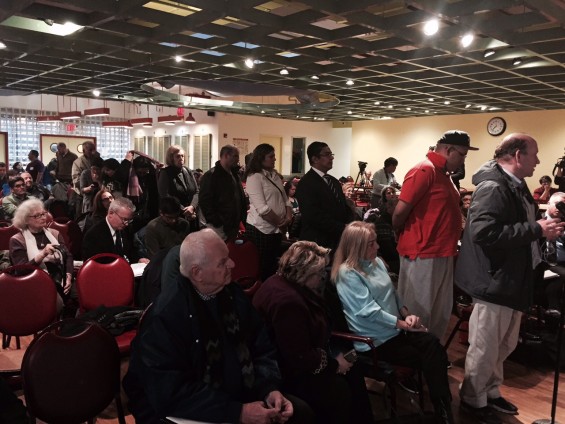
April 6, 2016 By Christian Murray
As residential towers go up and rezonings appear on the horizon, many 7 train commuters are skeptical that a years-long, $1 billion revamp of the line will alleviate overcrowding.
Ronnie Hakim, the president of MTA New York City Transit, spoke at a town hall meeting in Sunnyside Tuesday hosted by Council Member Jimmy Van Bramer and the subway advocacy group Access Queens. She told riders that the agency is close to finishing years of construction work that has led to numerous weekend service outages over the past three years.
Nevertheless, when the work is complete only two additional trains—carrying about 1,200 passengers each—will be able to get through the system per hour. Currently, 27 trains run per hour during peak time.
Several attendees said that this increase is not nearly enough to keep pace with the building boom.
The 7 train is already experiencing record high ridership of about 525,000 per week day, according to Hakim. She acknowledged that “ever increasing ridership will continue to pose challenges.”
Weekend closures between Long Island City and Manhattan will continue until the end of 2017, although the number of outages is expected to decline, Hakim said. In 2013, service was down for 17 weekends, while the number for 2016 was cut down to eight.

Hakim
The MTA has replaced most of the elevated track panels that are more than 25 years old, with the remainder of the work expected to be completed by the end of 2016.
The narrow tunnel that links the 7 train between Manhattan and Queens will be fully rehabilitated later this month after being damaged by flooding from Superstorm Sandy.
The line’s 100-year-old signal system is also slated to be replaced in its entirety by the end of 2017, Hakim said. The current “fixed block signal” system restricts trains from getting too close to one another, thereby limiting the flow of trains; it will be replaced by a new “Communication-Based Train Control” system (CBTC).
CBTC provides the MTA with data that tells it where a train is and what speed it is going. The modern system is expected to be more reliable and delays caused by “signal problems” are less likely to occur. Furthermore, when service is down, the MTA is able to get the system back up to full capacity much faster.
While commuters were pleased to hear the work on the 7 line is coming to an end, many urged the MTA for more service, noting the rapid development at Willets Point, Flushing, Long Island City and sections of Astoria.
Judy McClain, the MTA’s senior director of rail service, said that the 7 express train is currently at capacity and it is “exacerbated when service is somewhat irregular.”
There still remains some 7 train capacity on the local track, she said, although that quickly becomes overwhelmed when there is a gap in service.
“The two additional trains will help to some degree, but it really is dependent in terms of when this development comes on line,” McClain said.
She said that there is “a little more 7 train capacity in Long Island City” because the peak point is at Queensboro Plaza, where people transfer to the N and Q trains.
However, McClain said the N and Q trains are currently at capacity. She said that the E and F lines are also quite crowded, although there is some capacity on the R and M trains.
In terms of zoning, McClain said, “we have urged [the Department of] City Planning to focus on those areas and on those lines where we have capacity.”
However, Hakim said increased subway service is just one of many solutions to the transportation needs in the area. She said Select Bus Service and bus rapid transit were among the answers.
Van Bramer told the audience that there would be no rezoning—referring to Queens Plaza/Court Square—without transportation options increasing.
In the short term, Hakim said the MTA will be adding two extra 7 trains per hour in the evenings starting this fall. Furthermore, she said her staff would be making a greater effort to communicate what’s taking place with the public.
Wynton Habersham, an executive with the MTA, said the agency has been increasing its inspections of the system to reduce the chances of signal problems and other stoppages.
One Comment






Because of the acceleration of commercial and residential development in Hunters Point, Long Island City, Flushing and possibly Sunnyside, which could result in more riders taking the 7 train service, the MTA needs to finish replacing the older R62 subway cars with the newer R188 subway cars, renovating and retrofitting the Steinway Tunnel and replacing the older fixed-block signals with the newer moving-block signals via CBTC.